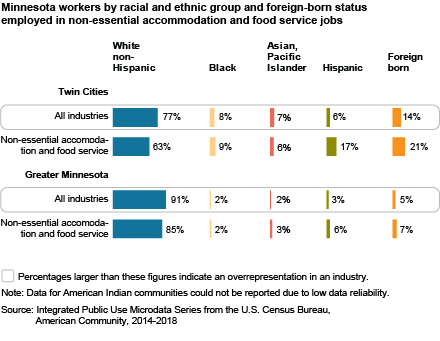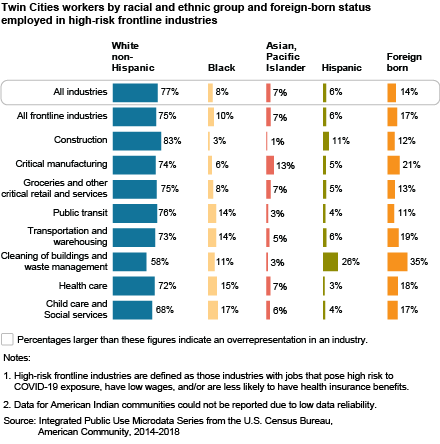by Ellen Wolter
By now, the data are clear: communities of color, particularly Black and Latino communities, have a higher COVID-19 infection and death rate than White communities, a reality that has laid bare racial and ethnic health disparities and inequities that have existed for years. But the disproportionate effects of the pandemic are not limited to health. Workers of color in Minnesota also have been more severely impacted by the economic challenges brought on by COVID-19. In fact, since the start of the COVID-19 pandemic, workers of color and immigrant workers have had the double disadvantage of being more likely to be furloughed or laid off and more likely to be frontline workers in critical industries. The bottom line is that, among Minnesota’s workforce, communities of color and immigrants are bearing the brunt of both economic hardship and exposure to health risks during the COVID-19 pandemic.
Large number of workers of color feel a pinch in the pocketbook
Statewide, workers of color, particularly Black and American Indian communities, are more likely than White workers to have filed for unemployment insurance since mid-March of 2020.
The industry hardest hit by COVID-19 restrictions in Minnesota has been the leisure and hospitality industry, which makes up 10% of all jobs in Minnesota. This industry is also more likely to employ workers of color. During the first few months of the pandemic, between March and April 2020, the leisure and hospitality industry suffered the largest number of jobs lost across all industries—a 53% decrease.
While the industry has since regained some jobs, overall the leisure and hospitality industry has lost 34% of its jobs since June 2019. Communities of color and immigrants in the Twin Cities and greater Minnesota are more likely to work in accommodation and food services jobs that are not essential and not on the frontline.

Frontline workers of color are more likely to be exposed to health risks, often with low wages and limited or few health benefits
Frontline workers continue to keep our communities functioning by providing access to food, community services, health care, child care, and transportation during the COVID-19 pandemic. However, workers of color and immigrant communities are disproportionately on the frontline in many critical industries that have low wages, have limited or no health insurance benefits, and put them in direct contact with the public or other working conditions that pose risks for contracting COVID-19. In the Twin Cities 7-county metro area, communities of color are more likely to work in frontline jobs overall—25% of frontline workers are of color compared with 23% of workers across all industries.
In the Twin Cities, Black and Latino workers are represented in frontline industries such as health care and child care at nearly 17% and 15%, respectively, despite being just 8% of workers across all industries. A quarter of Latino frontline workers are employed in cleaning and waste management positions and 11% in construction, while 6% of all workers are Latino.

Immigrant workers putting themselves at risk in critical frontline jobs
Across the Twin Cities metro and in greater Minnesota, immigrant workers are also disproportionately represented among frontline workers in the critical manufacturing industry, which has seen outbreaks of COVID-19 among meatpacking plants across greater Minnesota. In the Twin Cities metro, immigrant workers are more likely to be on the frontlines in transportation, cleaning and waste management, health care, and child care jobs.
Many frontline workers neither earn a lot of money nor have health insurance
In addition to having a higher risk of being exposed to COVID-19, many frontline workers in these industries are also more socially and economically vulnerable. For example, one-third of frontline workers living in the Twin Cities and greater Minnesota who work in the cleaning of buildings and waste industry have low incomes and live at or below 200% of the Federal Poverty Line (FPL), compared with 19% of all workers. In 2018, for a family of four, an annual income $25,152 is considered low-income, living at 200% of the FPL. Frontline workers in this industry are also less likely to have health insurance—9% in greater MN and 14% in the Twin Cities metro compared with 5% of all workers across the state.
In the new COVID-19 environment, Minnesota’s workers of color and immigrant workers disproportionately face economic and health risks for themselves and their families. The economic, social, and health impacts of the COVID-19 pandemic for Minnesota’s workers of color and immigrant workers exacerbates the racial, economic, and health disparities that already existed.
For more information about resources and organizations working to support racial inequities in Minnesota please see:
Minnesota Compass Racial Equity Resource Directory
Headwaters Foundation for Justice
Note: The methodology for this analysis was adapted for Minnesota based on studies provided by the Center for Economic and Policy (CEPR) and the Bay Area Equity Analysis, which produced analyses of frontline workers at the national, state, and local levels.